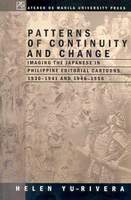 Helen Yu-Rivera. Patterns of continuity and change: Imaging the Japanese in Philippine editorial cartoons, 1930-1941 and 1946-1956. Quezon City: Ateneo de Manila Press, 2005.
Helen Yu-Rivera. Patterns of continuity and change: Imaging the Japanese in Philippine editorial cartoons, 1930-1941 and 1946-1956. Quezon City: Ateneo de Manila Press, 2005.
First published in Kasarinlan: Philippine Journal of Third World Studies 20, 1 (2005): 161-163
The first image in Helen Yu-Rivera’s book illustrates the highly unstable period following the First World War. A figure of a lady labeled “peace” admonishes a group of squabbling figures, dressed in military uniforms and costumes of world powers and other actors, to keep quiet, lest the God of War, Mars, wakes up. The power of images to condense and to state what lectures or articles could not in a highly constrained space of a two-dimensional plane is most apparent. This particular image expresses a generation’s feeling of foreboding. It depicts visually an assessment or, perhaps more precisely, the beginnings of the formation of a point of view that holds conditions of peace as ephemeral or as mere transitions to conditions of war. In one corner of a printed editorial page, the spirit of pessimism is evoked as a realist tone slowly pervades a drawn discourse on the tenor of the times.
Yu-Rivera’s very accessible book is a reading of several histories—of Japan’s search for recognition as a regional power and for what it perceived to be its rightful place next to the Western imperial powers; the strained relations of the Philippines and Japan, compounded by the undeniable presence of the rising world power, the United States; and the search for a lasting peace by peoples of the world through their proxies, the family of nation-states in the frameworks of the failed League of Nations and in the relatively triumphant United Nations. In brief, Yu-Rivera’s grand text talks about the Philippines as a nation among other nations, its insecurities, its preoccupations and its historically defined aspirations.
Yu-Rivera conjures thoughts and images that are both engaging and disturbing. Her discussion on the themes, symbols, and meanings in what otherwise would have been dismissed by many as another comic expressive mode reveals the power of artifact to make people think about the social condition, to set them into a certain path of collective decision, and to mobilize them toward achieving certain political goals. Yu-Rivera uncovers hidden discourses with surgical precision. For instance, her interpretation places the negative image of the Japanese in the “larger context of nationalism.” She puts forward a narrative of a people that have come to develop a feeling of “contempt for foreigners,” tired of being pushed around and used. Although quite convincing on this point, Yu-Rivera’s argument could have acquired more resonance through a brief or even a passing comparison of Japanese images with the images of other foreign powers. The long-nosed and finger-pointing visage of Uncle Sam unceasingly comes to this reviewer’s mind. Another example is seen in the Philippines consistently portrayed as a woman being wooed with a serenade (Figure 150) and wining and dining (Figure 130). One wonders if this tendency derives from a deeply embedded discourse of Philippine machismo, a case of seeing one’s nation and self as weak and impressionable and, therefore, in essence, a woman. Amusingly, and not at all surprisingly, the US penetration of the Philippine discourse on war reparations via the American cultural icon for generosity is revealed in a caricature of Prime Minister Hatoyama in a Santa Claus suit (Figure 144). Unfortunately for the Japanese, visual allusions to them are quickly lopped off by the caption: “Another Phoney Baloney.”
Yu-Rivera’s analysis shows how processes of constructing fear, loathing, and feelings of moral and even aesthetic superiority through a visual depiction of “others” coupled with a good helping of complementary texts all lead to an unsettling conclusion: the creation of symbols and images constitute an exercise of power in the arena of the minds of a receptive population. In Yu-Rivera’s text, the lesson of war sparing no enclave of peace or neutrality is well underscored. In a zero-sum game where the winner takes all, the site of cultural production like a battlefield is as fair as a game can be. Once penetrated, this site shifts to a different mode of production. Yes, it still appears to create, but it seems to create only rude perversions of reality. Thus, the slit eyes become more slit, and the bucktoothed more bucktoothed. As in many coercive engagements, reality becomes distorted. The “others” start to look less human, perhaps metaphorically, the better to kill.
Yu-Rivera’s book should be read, for as much as it takes us back to a sad period in our history it also reminds us of our dark side that was and still is being swept under the carpet of history. Yu-Rivera’s work seems to allude to a “Philippine gaze” and a “Philippine Orient” that are as ugly and as appalling in its ability to trivialize, to essentialize and to dehumanize as the numerous discourses of the West.—M.C.M. Santamaria, Associate Professor, Asian Center, University of the Philippines-Diliman.
Click this link to download the review in PDF.
Friday, August 11, 2006
Kasarinlan Review: Patterns of Continuity and Change
Posted by
UP Third World Studies Center
at
5:57 PM
![]()
Subscribe to:
Post Comments (Atom)


No comments:
Post a Comment